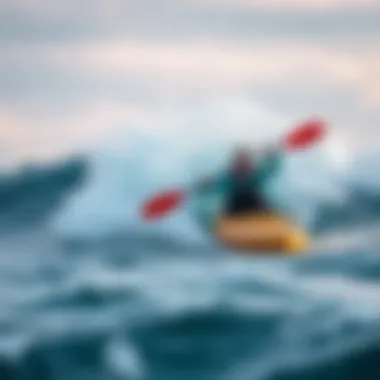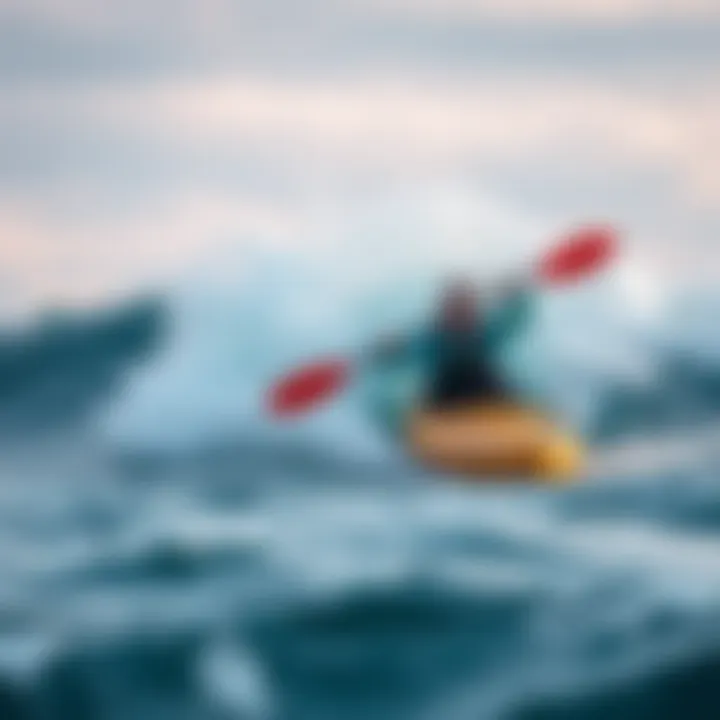Understanding the San Diego Swell Forecast for Watersports


Intro
The San Diego coastline is a paradise for watersports enthusiasts, attracting surfers, paddleboarders, and kayakers alike. The swell forecast plays a critical role in determining the best times to hit the water. Understanding how those swells behave can make all the difference between catching the perfect wave and spending your day battling choppy seas.
Swell predictions are not merely random guesses; they hinge on a variety of complex factors. From ocean currents and wind conditions to seasonal variations, each element plays a pivotal part in shaping the waves we experience off the shores of San Diego. This article dissects the swell forecast, offering insights into methodologies, useful tools for forecasting, and tips tailored for specific watersport activities. By grasping these concepts, readers can elevate their experience while navigating the surf.
Expert Insights
Gleaning from the vast knowledge of experts in the field reveals surprising trends in the world of watersports. These insights extend beyond just swell size and frequency. Here are some key observations that warrant attention:
- Popularity of Variable Conditions: Many surfers are increasingly opting for less-than-perfect days, valuing the challenge and unpredictability of the ocean.
- Focus on Sustainability: With the growing awareness of environmental impacts, there has been a notable trend towards eco-friendly gear and practices among athletes.
- Emergence of New Sports: The rise of foiling, a sport that requires smaller swells but offers a unique riding experience, has gained traction lately.
Advanced forecasting techniques and real-time data now make it possible for athletes to anticipate the daily dance of swells. Keeping an eye on these trends is essential for any professional hoping to keep their edge.
Latest Trends in Watersports
The dynamic nature of watersports means trends shift often. Some noteworthy trends in recent years include:
- Increased participation in adaptive sports—allowing individuals with disabilities to participate in activities like surfing and paddleboarding.
- The rise of virtual reality experiences, providing surrogates for ocean conditions to help new learners acclimate before hitting the waves.
- An uptick in competition-focused training, where athletes optimize their skills via technology, along with conventional training strategies.
Safety Protocols and Best Practices
After all, the ocean is as unpredictable as a cat on a hot tin roof. So everyone involved in dusky watersports should prioritize safety. Here are a few protocols to consider:
- Know Your Limits: This is not the time to push yourself into hazardous waters—most injuries stem from overconfidence.
- Check Weather and Forecasts: Always keep an eye on the latest swell forecast; it can save you from being caught unexpectedly.
- Wear Appropriate Gear: Equip yourself with the right safety gear, such as helmets, life vests, and leashes.
- Buddy Up: There’s an old saying, “Safety in numbers.” Never venture out alone in unpredictable conditions.
- Communicate: Always let someone know your plans before heading out; this ensures someone is aware of your whereabouts.
Equipment Recommendations
Must-Have Gear for Beginners
Starting out doesn’t have to be overwhelming. Here’s a succinct list of essentials that every beginner should get:
- Beginner Surfboard: A soft-top longboard is often recommended for stability. For example, brands like Wavestorm offer beginner-friendly options.
- Paddleboard: Opt for an inflatable board for ease of transport and stability, especially in calmer waters.
- Wetsuit: Depending on the season, a decent wetsuit can prolong your time in the water without getting chilled.
Advanced Equipment for Pros
For those already seasoned in the waves, investing in cutting-edge gear is vital:
- Performance Surfboard: Consider a shortboard for more advanced maneuvers. Brands like Channel Islands produce boards tailored for precision.
- High-End Paddleboards: Quality materials make a significant difference in weight and performance, so check out options from brands like BOTE.
- Deck Pads: Proper grip is critical, especially in high-performance paddleboarding. Surf companies often offer tailored pads that fit specific boards.
With a comprehensive understanding of swell forecasts, expert insights, and essential gear, watersport athletes can fully embrace everything the San Diego coastline has to offer. Stay astute, and you might just catch that perfect wave.
Understanding Swell Dynamics
Swell dynamics form the backbone of any discussion surrounding ocean conditions, particularly for those who engage in watersports. Understanding how swells behave can be the difference between a thrilling day on the water and a dangerous experience. The swell refers to the waves generated in the open ocean, which travel vast distances before reaching the shore. This enables various activities like surfing, kayaking, and paddleboarding to thrive.
By delving into the nuances of swell dynamics, athletes, coaches, and recreationists can equip themselves with the knowledge to make informed decisions. This understanding enhances the quality of experience on the water and minimizes risks associated with unpredictable conditions.
Definition of Swell
In simplest terms, swell is a series of waves that progress across the ocean surface, often generated by distant storms. Unlike chop or locally generated waves, swells are organized and can travel thousands of miles intact. Their energy is derived from wind, which dictates their height, period, and direction. Notably, swells can persist long after the wind has died down in the area, allowing for a prime surf session even when conditions seem less than favorable on the surface. A swell of 10 feet may seem daunting, but for seasoned surfers, it could be an invitation for exhilaration.
Key Characteristics of Swell


Several characteristics define swell, making it essential for those involved in water-based activities:
- Wave Period: This refers to the time between the passing of successive wave crests. A longer wave period generally indicates more powerful swells, which provide better surfing conditions.
- Wave Height: The height can range considerably, impacting both visual aesthetics and safety. While larger swells can provide thrilling opportunities, they also present higher risks.
- Wave Direction: Swells can approach from different angles, depending on storm systems’ location. Understanding this helps surfers position themselves effectively.
- Consistency: A constant swell produces sets of waves that create more enjoyable and predictable conditions.
Having a keen eye for these characteristics allows enthusiasts to anticipate how the water will behave.
Role of Wind in Swell Formation
Wind plays a crucial part in swell formation, acting as the primary energy source for the waves we see rolling onto the beach. Factors like wind speed, duration, and the distance over which it blows (fetch) all contribute to the swell's development. Strong winds over a long fetch will create larger, more powerful swells, while lighter winds may result in smaller, less organized swells.
Moreover, the direction of the wind can interact with the coastal features, creating localized effects that can enhance or diminish the swell's impact. For example, in San Diego, offshore winds can help maintain wave shape, while onshore winds can disrupt it.
Understanding these dynamics provides a critical edge for those looking to maximize their time on the water. As wind conditions can change rapidly, staying alert to shifts in weather patterns can be the ticket to an exceptional day at sea.
"Nailing down the dynamics of swell is like having a cheat sheet for the ocean – it can turn the tide in your favor."
By comprehending swell dynamics, water sports enthusiasts can navigate their craft with more precision, ensuring that each outing is safe and satisfying.
Factors Influencing San Diego's Swell Forecast
Understanding what sways the swell conditions along the San Diego coast is key for any watersport enthusiast. From surfing to kayaking, multiple elements come into play. The right knowledge can make the difference between a perfect day on the water and a disappointing outing. In this section, we’ll break down three primary components influencing the swell forecasts: local wind patterns, ocean currents, and seasonal variations.
Local Wind Patterns
Local winds typically act as the driving force behind the formation of swell, making it one of the most critical aspects to consider. Winds that blow across the ocean surface create waves that can travel vast distances. These waves, driven by consistent wind patterns, have a significant impact on the swell experienced at specific beaches.
When it comes to San Diego, the prevalent winds tend to blow from the northwest, particularly during the summer months. However, this can vary in the winter months when storm systems bring different wind directions. For surfers, understanding whether a day will feature offshore winds—winds blowing from land to sea—or onshore winds can dictate the quality of the surf. Onshore winds can create choppy conditions, while offshore winds often lead to cleaner, more organized swell. It’s essential to tap into resources like the National Weather Service or local surf reports to stay ahead of these changes.
"Good wind can make a mediocre day into a great one, while poor wind can ruin the best swell."
Ocean Currents and Their Effects
Ocean currents play a huge part in how swell propagates and behaves when it reaches shore. These currents can either enhance or diminish the conditions as they interact with incoming waves. In San Diego, several major currents contribute to the local swell situation, including the California Current, which flows southward along the West Coast.
Understanding these currents is vital. For instance, the California Current can keep the water temperature cooler, influencing the overall conditions experienced. Meanwhile, eddies formed by ocean currents can alter how waves break when they hit the coastline. These shifts can create localized variations, which can make certain spots better for surfing or kayaking compared to others on any given day. Always consider checking real-time oceanographic data when planning water activities—this knowledge will help you predict the best spots and times for your favorite watersports.
Seasonal Variations
Swell patterns are noticeably influenced by the changing of seasons. Between summer and winter, surfers can expect a variety of conditions that would appeal to different skill levels. During summer, smaller swells driven by weaker storms can make for ideal conditions for beginners or recreational kayakers. In contrast, the winter months often bring larger swells generated by intense storms in the North Pacific, tailored for more advanced surfers looking for a challenge.
It's also worthwhile to remember that San Diego can occasionally experience significant swells from Southern Hemisphere swells, particularly during late spring and early fall. These swells can deliver some of the most favorable conditions that surfers dream of. Seasonal timing is not just about size but also about consistency—understanding these trends is key to planning your activities.
Tools for Swell Forecasting
The art of forecasting swells has come a long way from gut feelings and local knowledge. With technology at our fingertips, watersport enthusiasts, whether they be surfers, kayakers, or paddleboarders, can access real-time data that shapes their adventures on the water. Understanding the tools available for swell forecasting is essential, as it allows for informed decisions about when to hit the waves. This section delves into various resources that can enhance one’s experience in San Diego’s dynamic ocean environment.
Online Forecast Platforms
Online platforms are the go-to resource for most watersports enthusiasts. These tools aggregate data from various sources to provide comprehensive swell forecasts. Notable websites like Surfline or Magic Seaweed are pivotal in this space. They present information not only on swell height and period but also on wind conditions, tide charts, and even human reports from other surfers on the scene. With a clean interface and constant updates, one can see at a glance when conditions are ripe for surfing or paddling.
Moreover, the interactive maps offered on these platforms allow users to visualize swell patterns and ocean currents that can influence local conditions. Accessing various beaches in San Diego, one can ascertain where to expect the best surf, or find a sheltered cove ideal for kayaking.
"Using a reliable online forecast platform can mean the difference between a perfect day out and getting skunked by the ocean's unpredictability."
Mobile Applications for Real-Time Updates


In today’s fast-paced world, mobile applications are indispensable for immediate access to swell forecasts. Apps like Windy or Surfline’s dedicated app bring the ocean’s vital statistics directly to one’s pocket. These apps often provide instant notifications on significant changes in conditions, such as shifting winds or unforeseen storms.
The ability to check the forecast while at work or on the go means that avid surfers or paddlers can squeeze every bit of potential out of their time. Many of these mobile tools utilize GPS data to ensure the forecasts are hyper-local, tailoring predictions to specific spots in San Diego. Having access to such information in the palm of your hand changes the game, enabling users to adjust plans in real-time.
Utilizing Weather Buoys and Sensors
Weather buoys play a crucial role in gathering accurate oceanic data. These floating devices collect real-time information about wave height, temperature, and current, transmitting essential data back to meteorological services. For San Diego, where ocean conditions can shift rapidly, these buoys provide critical insights that feed into the swell forecasting models.
This technology allows for a more scientific approach to understanding various factors that affect swell patterns. Through these sensors, data can be compiled over time to identify trends, which is particularly valuable during seasonal shifts or unusual weather patterns. Although not common knowledge among casual waterborne adventurers, those serious about their sport should utilize this extensive data.
Implications for Watersports Activities
Understanding the implications of swell forecasts is paramount for anyone engaged in watersports along the San Diego coastline. Efficient swell forecasting translates directly into safer, more enjoyable experiences for surfers, kayakers, and paddleboarders alike. By being aware of the predicted swell conditions, enthusiasts can minimize risks and maximize their time spent riding the waves or paddling through scenic waters.
"Knowledge is power—especially when it comes to knowing what the ocean might throw at you."
Surfing: Optimal Conditions Analysis
The art of surfing hinges on recognizing the nuances of ocean swell. Optimal surfing conditions often depend on a blend of swell height, period, and direction. For instance, a swell in the 3 to 5-foot range arriving every 10 to 12 seconds is generally considered ideal for intermediate surfers on a beach break. More experienced surfers may relish larger swells, while beginners would likely benefit from smaller, slower waves for practice.
Key Factors to Consider:
- Swell Height: Affects both the challenge and safety when riding the waves.
- Swell Period: Longer intervals between swells typically allow for smoother rides, as the waves have time to build.
- Swell Direction: Knowing which way the swell is heading can help surfers find the best spots. Regions facing directly towards the swell will see better breaks.
It's also vital to note how local wind patterns interact with the swell. Offshore winds can create glassy conditions, while onshore winds often lead to choppy waters. Keeping an eye on both swell forecasts and wind conditions will ensure a fulfilling day on the waves.
Kayaking and Safety Considerations
For kayakers, swell forecasts are critical in determining the safety of navigating coastal waters. Large swells can create unpredictable conditions, particularly in areas with rip currents or rocky outcrops. Before embarking on any kayaking journey, one must assess the predicted swell height and wind conditions to make an informed decision.
Precautionary Steps:
- Check Weather Conditions: Look for any rapidly changing weather patterns that might affect the ocean.
- Know Your Limits: If conditions seem beyond your skill level, it’s prudent to choose another day or a calmer route.
- Use Safety Gear: Ensure you have a personal flotation device, whistle, and a reliable means of communication, especially in swells above 2 feet.
Paddleboarding: Best Practices for Various Swell Sizes
Paddleboarding offers a unique perspective of the sea, but swell conditions can greatly affect the experience. Smaller swells can make for a tranquil paddle, ideal for beginners or those looking to practice balance. Conversely, larger swells can present thrilling challenges, but safety must remain the priority. Different swell sizes necessitate different strategies and techniques.
Best Practices:
- For Small Swells (1-2 feet): Perfect for newcomers. Focus on form and balance.
- For Medium Swells (2-4 feet): Intermediate paddlers should practice paddling against the swell, perfecting both strength and stability.
- For Large Swells (4+ feet): Experienced riders should use swift strokes to navigate, always being aware of the risk of falling or capsizing.
Adapting one's approach to the changing swell patterns not only enhances the experience but also dramatically improves safety on the water. Learning from each outing and keeping abreast of current forecasts can help refine skills over time.
Analyzing Local Geographic Impact
Understanding the geographic aspects of San Diego's coastline is crucial for grasping the full scope of swell dynamics. The local topography, with its varied shapes and landforms, plays a pivotal role in how ocean swells interact with the shore. It can affect wave sizes, break patterns, and ultimately, the overall surfing experience. Given the region's popularity for watersports, recognizing the geographical impact not only aids athletes but also enriches coaching strategies for better performance and safety.
Coastal Topography and Its Influence
When we talk about coastal topography, we're looking primarily at the way the land meets the ocean. In San Diego, cliffs, sandy beaches, and rocky outcrops create a complex interaction with incoming swells. Each geographic feature alters the swell forces in unique ways. For instance, submerged reefs can result in sharper waves, while wide sandy beaches might lead to softer, more forgiving swells.
Several factors come into play here:
- Slope: Steep slopes can cause waves to break more aggressively, while gently sloping beaches might allow for longer rides.
- Orientation: Depending on whether the coastline faces north, south, east, or west, surfers may experience vastly different swell conditions.
- Structure: Natural or artificial structures, like piers or jetties, can redirect or amplify swell, creating localized spots for optimal surf action.


Understanding these elements means athletes can better pick their spots. Imagine a surfer heading to a hidden gem on the coastline but not realizing the reef structures nearby will alter the swell dramatically. Knowledge of local topography empowers better decision-making, ensuring both safety and performance are prioritized.
Bays and Coves: Unique Conditions
Bays and coves present a different set of dynamics altogether. These sheltered areas often create unique conditions that can provide calmer waters, making them a preferred choice for certain activities. Instead of the relentless pounding of open ocean swells, surfers might find themselves navigating smaller, more manageable waves. This is particularly beneficial for novice watersport enthusiasts who are looking to hone their skills in a less hazardous environment.
Key characteristics of bays and coves include:
- Protection from Wind: The surrounding land often breaks up harsh wind conditions, leading to smoother surfaces, which can be more inviting for paddleboarding and kayaking.
- Microclimates: Local weather conditions can vary significantly within these areas, leading to more consistent and favorable conditions for activities like kayaking and paddleboarding as opposed to surfing.
- Tide Effects: Tidal changes can radically shift the characteristics of these venues, exposing more of the beach or altering the wave breaks.
By comprehending the nuances of bays and coves, athletes can strategize their activities based on their skill level and environmental conditions. In essence, the interplay of coastal topography influences not just swell size but has broader implications for safety and enjoyment on the water.
Understanding the local geography is like having a map to navigate your way through great surf experiences, enhancing both skillset and safety.
Long-term Trends in Swell Patterns
Long-term trends in swell patterns are crucial for understanding how the characteristic waves of San Diego evolve over time. These patterns have implications not just for enthusiasts and athletes, but also for coastal ecology, urban planning, and beach safety. Analyzing swell trends provides insights into how persistent atmospheric and oceanic changes influence the coastline, which can affect the equipment choices for recreationists and coaching strategies for athletes.
Climate Change Effects on Ocean Conditions
Climate change is reshaping ocean conditions, and it’s essential to understand its impact on swell dynamics. Rising sea temperatures not only affect wave formation but also influence the frequency and intensity of storms. As water heats up, hurricanes and strong winds may become more common, altering swell patterns in ways that can affect the predictability of conditions for water sports.
- Warmer Waters: Higher temperatures can change ocean stratification, which in turn affects how energy travels across the sea surface.
- Increased Storm Activity: More frequent and intense storms can lead to erratic swell events, making it harder for surfers and other water sports enthusiasts to forecast conditions.
- Shifts in Currents: As climate change disrupts traditional ocean currents, the travel and shape of swells can also change, impacting surf spots significantly.
"Understanding these changes in swell patterns is like reading the ocean’s diary, revealing how our environment reacts to our actions."
By monitoring these trends, water sports enthusiasts can adapt their practices, ensuring they remain prepared for the changing nature of our oceans.
Historical Swell Data Analysis
Analyzing historical swell data is invaluable for discerning long-term trends. By compiling and examining past swell records, researchers can establish baseline conditions that help in predicting future scenarios. This data can be instrumental for tactical decisions in surfing and paddleboarding.
- Data Availability: Many surf forecasting websites and oceanographic institutions provide historical data repositories that track not just wave heights, but also wind patterns and tidal movements.
- Pattern Recognition: Identifying patterns in past swells allows surfers to anticipate upcoming conditions during specific seasons or after extreme weather events.
- Local Knowledge: Historical data blended with local geography can produce insights only seasoned athletes might glean otherwise.
For the serious athlete or coach, leveraging historical swell data can enhance training regimens and competitions. By anchoring their strategies in empirical data, they can make more informed decisions that respect how the local environment is trending.
Finale: Forecasting Future Swell Dynamics
In wrapping up our extensive exploration of swell forecasting in San Diego, it's essential to emphasize that understanding how to predict these oceanic patterns can dramatically enhance the experience for surf enthusiasts, sailors, and paddlers alike. The implications of swell forecasting reach beyond mere predictions; they influence safety measures, equipment choices, and overall enjoyment of watersport activities.
Why Predictive Models Matter
Integrating predictive models into swell forecasting is not merely a luxury; it's become a necessity for those navigating the ever-changing coastal conditions. Considering the interplay between various environmental factors, these models analyze data from historical patterns, real-time ocean buoy measurements, and atmospheric inputs such as wind speed and direction.
"Successful prediction hinges not just on guesswork, but on synthesizing complex systems in a manner that’s both efficient and precise."
Benefits and Considerations
Here are some vital benefits of these predictive models:
- Enhanced Safety: By forecasting swell patterns accurately, adventurers can make informed decisions that prioritize their safety on the water. Specific predictive models can alert early to high-risk conditions, allowing users to avoid dangerous swells.
- Optimized Performance: For surfers or paddleboarders, knowing the type and size of expected swells can influence equipment choices, from board selection to fin configurations. This knowledge often means the difference between a mediocre day on the water and a remarkable one.
- Event Planning: Water sports events can greatly benefit from accurate swell forecasts, as they can help organizers choose optimal times for competitions or gatherings, ensuring conditions are favorable for all participants.
Final Thoughts
As climate change and weather patterns continue to evolve, ongoing adaptation of predictive models will become increasingly crucial. Stakeholders across the board—from sports organizations to environmentalists—must advocate for more robust data collection methods, improving the integrity and accuracy of these models.
By understanding the significance of swell forecasting and engaging with the methodologies discussed above, those involved in watersports can make educated decisions. The San Diego coastline, with its varied conditions and unique geography, offers an ocean of possibilities. Predictive models allow enthusiasts to ride these waves wisely, ensuring safe and gratifying experiences on the water.
For additional info on swell forecasting tools, visit NOAA or check resources like SurfLine and MagicSeaweed.
Ultimately, embracing these advancements in forecasting technology can lead to a more enjoyable, safe, and predictable interaction with the ocean.







